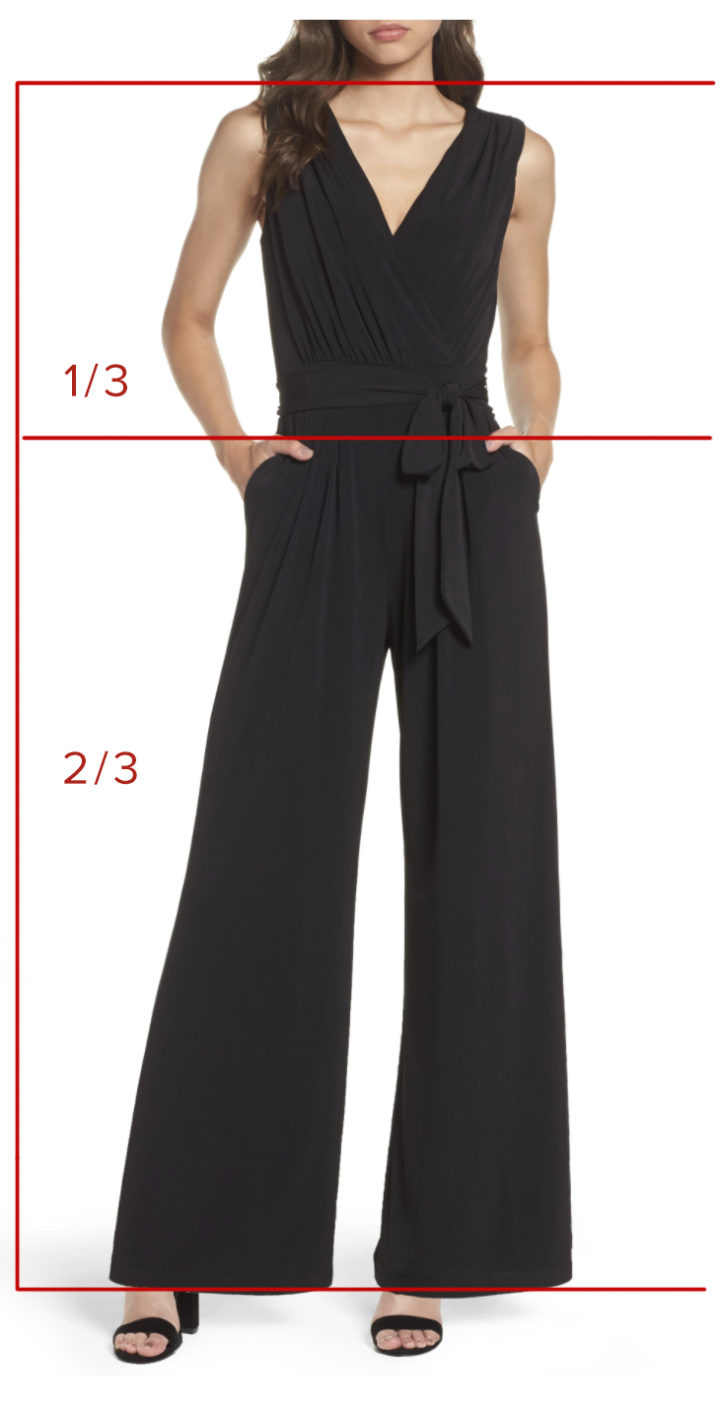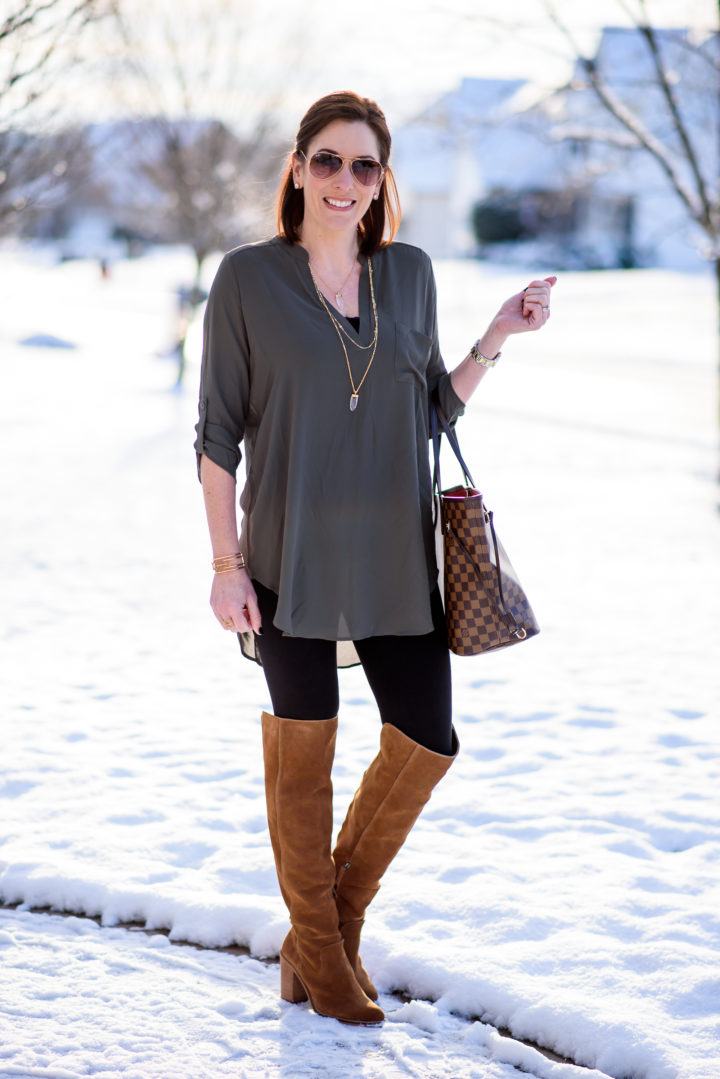UNDERSTANDING RULE OF THIRDS IN FASHION
There’s a concept called Rule of Thirds that will help you put together more flattering outfits almost instantly. No matter how cute the individual pieces are, if the proportion of your outfit is off, it may look frumpy or unflattering.
I often mention the 1/3 to 2/3 ratio when discussing my outfits, and it usually elicits some requests for more explanation.

This concept is actually based in architecture. As Coco Chanel once said, “Fashion is architecture; it is a matter of proportions.”
A balanced one-to-one ratio is boring and expected, whereas unbalanced proportions are interesting and pleasing to look at. It’s generally accepted that a 1/3 to 2/3 ratio is the most aesthetically pleasing division of spaces, and that’s called the Golden Ratio in artistic circles.
Take a look at the Eiffel Tower, often cited as a perfect example of this concept. I drew lines to show the Golden Ratio in action — in this case, 2/3 on the top and 1/3 on the bottom.

Painters and photographers use this same ratio to compose their works. For example, it’s much more interesting to place the horizon of a landscape in the top or bottom third of the image, rather than the middle.
This is what a lot of people tend to do… that’s if they even bother to straighten the horizon. #petpeeve

See how much better this one looks, with the horizon in the top 1/3 of the picture?

RULE OF THIRDS IN FASHION
The rule of thirds applies to fashion as well! Take a look at this well-balanced outfit.
In this case, the 1/3 is on the top, and the 2/3 is on the bottom.

I achieved this balance by front-tucking my top. If I had left it untucked, it would have cut me right in half, which can look boxy and unflattering.
The front tuck brings the top up, allowing more of my legs to show, and emphasizing my waist.
This is an example with a basic t-shirt and jeans outfit.

You may notice in both of the above pictures, I drew the bottom line at the end of the pants, not the bottom of the shoes.
This is because in both cases, the jeans are dark and my skin is light, so there’s high contrast between the jeans and my legs.
In this 2nd example, the shoes are pretty much the color of my skin, and in the first example, the shoes are very strappy, so you really see more skin than shoe.
Visually, the outfit sort of stops at the bottom of the pants, at least for ratio purposes. If I was wearing boots that covered the foot and leg, I would draw the line at the bottom of the boots.
Here’s another outfit with the black jeans to illustrate my point.

Also, I drew the top line at the top of the collar of the jacket, but perhaps it should be drawn at the top of the leopard sweater… either way, the 1/3 to 2/3 ratio is in effect here. It doesn’t have to be exact, it’s just a guideline.
You don’t have to front tuck every top to achieve the right balance, though. Some tops are the right length to work with your outfit without a tuck. This is why we are seeing a return of shorter tops, now that pant lengths are rising.
If you wear a longer top with crop pants, you will end up with a 50/50 split, or a 1:1 ratio, rather than 2:1.
This sweater is about 24″ long, so on my 5’5″ frame, I can easily wear it untucked with most of my jeans and still get a pretty good 2:1 ratio.

But sometimes switching pants is easier than finding a different top. If you’re wearing a longer top you love, and you put on cropped pants and realize your legs look short and stumpy, try longer pants.
Or add a shoe the same color as the pants, to create even more length on the bottom to offset the length on top.
Here’s an example with shorts. In this case, the top is 2/3 and the shorts are 1/3.

And here’s an example with a dress. The dress is the 2/3 and the legs and shoes are 1/3. I guess this is why I like knee-length dresses so much!

Of course, long dresses can be flattering too, but this is one reason why belting a long dress is more flattering than allowing it to hang all one length. The belt creates that 1/3 to 2/3 ratio, instead of having one long column.
And this is also why most long dresses have a waist band of some sort. Take this jumpsuit for example. See how the tie waist divides it into thirds? The top of the jumpsuit is 1/3, and the bottom is 2/3.

So as you put future outfits together, think in terms of dividing the overall look into thirds rather than halves or quarters.
There are lots of ways to do this, but basically, you want to look for a long and a shorter garment to put together instead of two items that are the same length.
How about cardigans? There are several factors to consider when layering. Color and level of contrast between the items in your outfit will affect how your eye reads the proportions, so every outfit is different, but I’ll show you a common example.
Longer cardigans are trending, so I found an outfit with an ivory tank, black pants, and camel long cardigan. I actually see two golden ratios in this outfit. First, let’s divide it into thirds.

Usually, the under layer is the one that draws the eye, and that’s the case here. The tank is 1/3 of the look, and the pants are 2/3. The cardigan frames the outfit, but you still see that golden ratio in the under layer.

But you also get the 2:1 ratio going on with the cardigan and the pants, except the cardigan is 2/3 and the pants are 1/3. It kind of cool, that it works both ways.

A few have asked about tunics. I’m not a big fan of tunics in general because they tend to add visual weight due to the lack of structure and longer length. However, it can work.
Who remembers this blast from the past? I think everyone had this tunic in at least three colors!

This look is a little dated, but you can see how a longer tunic with black leggings and boots can give you an illusion of the 1:2 ratio. It’s not exact, but it’s not 1:1 either.
Here’s the same tunic with black leggings and contrasting boots. Again, the outfit is a bit dated, but I think it’s a pleasing balance of proportions.
The tunic is the 2/3, and the boots are the 1/3, and then the leggings provide some separation… maybe that’s not the right way to analyze it, but it makes sense to me.

Also, the 3/4 sleeves and the drapey material of this tunic help it not look too voluminous. The sleeves draw the eye to the waist, and the material drapes nicely over the hips rather than hanging straight.
What about a skirt and top? In this case, the skirt, top, and legs are each 1/3 of the outfit. I don’t have a lot of skirt examples, because frankly, I struggle to find tops that are short enough, and front tucking can look odd.
Here’s one I found… I drew the lines where the items SHOULD end. I think this would look better if the skirt were a couple inches longer, and the sweater perhaps an inch shorter. I don’t like where it cuts across my belly.

Here’s that same sweater with a skirt that’s about an inch longer, and with black tights and black boots. I like this better.

Remember, it’s not an exact science, and it doesn’t have to measure out perfectly. It’s just a guideline.
It often requires some final tweaking and zhuzhing to get an outfit just right — maybe tucking in your top, adding a jacket, switching to longer pants, changing the color or style of your shoes, etc.
Play around with it, and have fun! And the next time you look in the mirror, and you like your outfit but feel like something isn’t quite right, check the proportions. It may just require a simple tweak, like tucking in your top, or matching your shoe to your pants to make all the difference!
DON’T MISS A POST!
Subscribe to get email updates! In addition to my most recent blog posts, you’ll receive exclusive newsletter content like special sales, my newest favorite finds, and an occasional peek behind the scenes — all delivered right to your inbox. PLUS you’ll be automatically entered for a chance to win a $100 gift card each month!
This post contains affiliate links. When you shop through my links, it helps support my business (at no additional cost to you) so thank you!
Related
Discover more from ReviewFitHealth.com
Subscribe to get the latest posts sent to your email.
Fashion is not just about wearing stylish clothes; it’s about creating visually appealing ensembles that capture attention and express individual style. One of the key principles that can transform an outfit from ordinary to outstanding is the rule of thirds. Understanding and applying this concept to fashion dressing can elevate your style game and make a lasting impression.